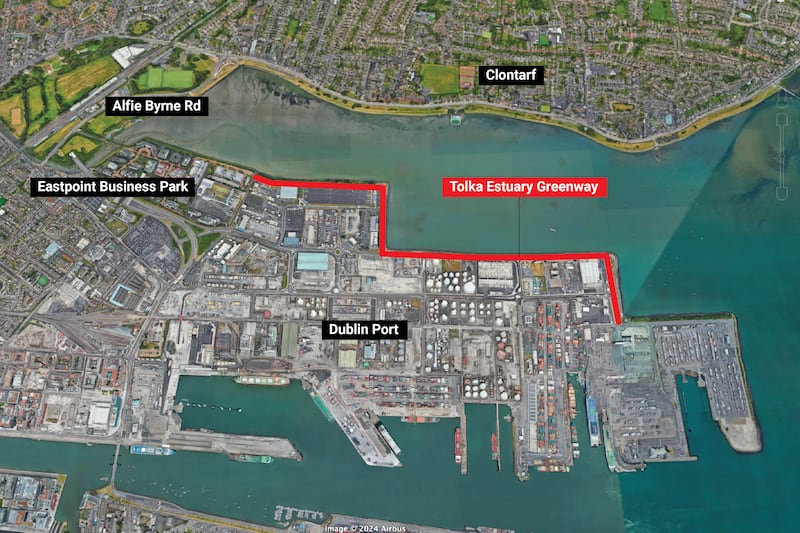A new Dublin Bay cycle route, which will provide cyclists with safe, segregated, access to ferry terminals and port facilities for the first time, has opened in Dublin Port.
The almost-2km route will take cyclists and pedestrians from the northern edge of the port lands at the East Point Business Park, along the perimeter of the bay opposite the Clontarf promenade.
The route, which Dublin Port Company is calling the Tolka Estuary Greenway, is the first phase of a €25 million project to open the port lands to the public and provide more than 16km of cycle paths through Dublin Port, to ferry terminals and industrial facilities.
The port routes will bridge a major gap in the provision of coastal cycling infrastructure across Dublin Bay, and will provide a starting point for the national Dublin to Galway cycleway.
RM Block
By using the greenway, cyclists arriving by ferry from Holyhead in Wales and Cherbourg in France will no longer have to share the road with cars and large lorries. The path will also facilitate safe cycling within the port campus for its 4,000 workers, many of whom use e-scooters to get around.
The new route will also be available to cyclists and pedestrians who are not ferry-bound, opening up previously inaccessible parts of the port and the Dublin coastline to the public. Three “discovery points” have been installed along the route with observation platforms offering views across Dublin Bay and interpretive panels to give context to the heritage and history of Dublin as a port city.
The Tolka Estuary Greenway provides access to the Clontarf cycle route, which now runs from Sutton to the city, through the Alfie Byrne Road connection. Direct access to the Liffey-side cycle paths through the port will be provided in the next phase of construction with a 1.4km route running from Eastpoint Business Park to the roundabout before the Tom Clarke (Eastlink) bridge.
The port company last October secured permission from An Bord Pleanála for this route, which runs directly south within the port lands parallel to Bond Road and East Wall Road. It plans to begin construction early next year with completion expected within 18 months.
While the estuary path will provide the shortest trip for cyclists heading to and from the port to the north of Dublin, the Alexander Road entrance, currently the main route used by all port traffic not using the Dublin Tunnel, remains the more direct route for cyclists coming from other parts of the city.
However, Lar Joye, port heritage director, said, it will not be the fastest.
“On Alexander Road you have the traffic slowing you down, it’s stop-start with traffic lights and roundabouts. This new greenway will be about half a kilometre longer, but for cyclists with all that traffic infrastructure eliminated, it will be faster, as well as an awful lot nicer.”

For cyclists and walkers who are not ferry-bound, the greenway routes will continue on around the coast to the end of the northern section of the port lands. This final section, after the ferry terminals, involves further sea defences work and a linear park, and is due to be completed in about two years’ time.
The port will also be the eastern starting point of the Dublin-to-Galway cycleway, a 270km dedicated traffic-free cycling route, which has been substantially completed from Maynooth to Athlone, with parts already finished and under construction in Dublin along the Royal Canal. This route will eventually link Ireland, through the ferry port, with EuroVelo 2, a 5,500km cycling east-west European cycling route.
- Sign up for push alerts and have the best news, analysis and comment delivered directly to your phone
- Join The Irish Times on WhatsApp and stay up to date
- Listen to our Inside Politics podcast for the best political chat and analysis














